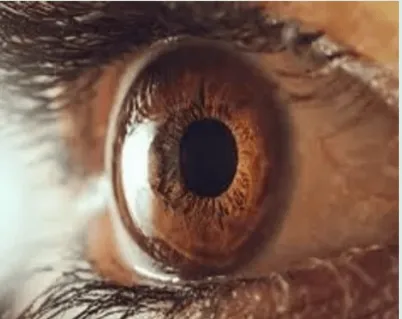Abrasion in the eye typically affects the superficial layer of the cornea – mainly the epithelium and possibly the epithelial basement membrane. To better understand these affected parts, we need to understand certain parts of the eye and the layers that make up the cornea.
On average, the cornea thickness is about 0.5mm and the epithelium is approximately 0.05mm. This makes up around 10% of the overall thickness of the cornea and is made of 6 layers of epithelium cells.
The epithelium, together with the tear film, contributes to the maintenance of the optically smooth corneal surface.
Most of the time after scratching your eye, you only damage the epithelial cells and sometimes disrupt the intercellular connections. If the scratch is deeper, and you break the hemidesmosomes (the connection between the epithelial cells and the underlying basement membrane) it may cause recurrent corneal erosion syndrome (RES), which is a condition causing repeatable painful episodes from spontaneous corneal abrasions.
A corneal abrasion is usually caused by a fingernail scratch, which can be your own doing or your baby or child. Other times, it can be the result of blunt trauma, such as walking into something or a foreign body entering the eye, like grit or sand.
For example, for corneal strength to be reduced to 60% post SMILE, PRK, LASIK procedures, it would translate to an approximate correction of -13.50 D, -10.00D, -5.75D respectively, with 7.75D difference between LASIK and SMILE for a cornea of the same postoperative relative total tensile strength. LASIK surgery creates a corneal flap with a 90% decrease in central nerve fibre density for the first few months, which is mainly responsible for the dry eyes symptoms. On the other hand, SMILE procedure involves only small incision without photo ablation. This has less impact on corneal innervation meaning SMILE greatly decreases the incidence of postoperative dry eye disease compared with LASIK. Higher order aberration (HOA) is an important contributor to postoperative optical quality. It is usually increased following laser refractive surgery, which might deter the quality of vision. SMILE procedure induces less HOA in comparison to LASIK. This may be attributed to the small corneal incision. The visual outcome of the three procedures are similar, however, the SMILE has no haze and induce less visual aberrations compared with the LASEK and LASIK.
The cornea is a very sensitive part of your body. A small scratch can be quite painful, as it exposes the sensory nerve endings, making the scratch feel much bigger than it actually is. The usual symptoms of a corneal scratch are:
An ophthalmologist can detect a corneal scratch using a slit lamp examination, which will allow them to see the exposed epithelium..
The epithelium, together with the tear film, contributes to the maintenance of the optically smooth corneal surface.
RES causes sharp painful eyes, usually after waking up, and the condition is also associated with similar symptoms such as watery, red eyes and photophobia. Often, the patient presents with a history of a scratched eye, which could date back to a few days or a few years ago. Most of the patients I see have developed RES from a baby fingernail scratch..
When we have something in our eyes, we have a tendency to rub them, thinking it will make the object go away. Sometimes, this actually causes more damage. Try to wash your eyes out gently with water instead of rubbing them.
There are some groups of people that are more prone to corneal abrasions. For example, if you work in an environment with flying dust particles – like builders or field workers – it is advisable to wear protective goggles at all times to prevent foreign bodies from embedding the cornea.
As for parents with babies, they need to keep aware that infants would like to explore, sometimes using their hands to inspect parents faces, which might, unfortunately, cause a corneal scratch. So keeping babies fingernails clipped with no sharp edges could be a good preventative measure.
In general, corneal abrasions will heal without treatment within 1-2 days, depending on the size of the damaged epithelium layer.
Lubrication & bandage contact lenses – eye drops can provide lubrication and help speed up the healing process. Bandage contact lenses may also provide comfort and prevent rubbing from the blinking eyelids. If the corneal scratch is deep enough to rupture the basement membrane and the patient develops RES, then lubricating eye drops and gel are the first line of treatment to prevent painful episodes upon waking up..
Antibiotics – Some people decide to cover the eye with antibiotic drops until the defect heals. This is a good strategy to prevent infection as the epithelial layer has ruptured and is the eye’s first layer of defense against pathogen penetration.
Hypertonic ointment – If previous treatments are not enough, then applying hypertonic ointment, such as sodium chloride ointment 5%, during sleep would help prevent swelling. This swelling typically happens during the closure of eyelids and supposedly triggers the breaks in the epithelium layer in RES.
The course of sodium chloride eye ointment is usually for six months, as the usual time for the hemidesmosomes to establish an adequate connection between the epithelial layer and basement membrane, is around four months.
If all treatments above fail to provide relief, the next step in the treatment ladder would involve surgery, such as epithelial layer debridement or applying laser treatment on the surface of the cornea. Both methods are to encourage strong adhesion between the epithelial layer and the underlying tissue.
Mr Radwan Almousa is a highly skilled consultant ophthalmologist based in London. If you believe you have any of the symptoms mentioned in this article, you can talk to him by booking an e-Consultation through his Top Doctors profile.

